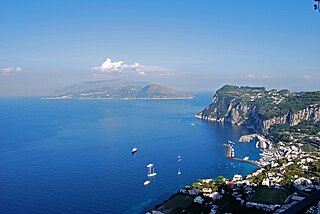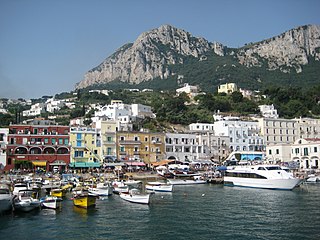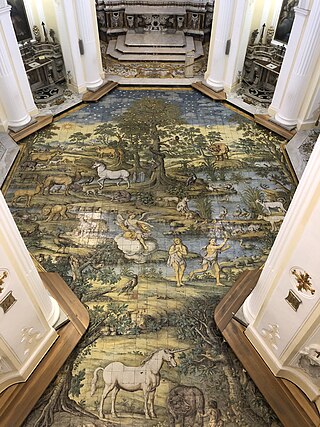
Naples is the regional capital of Campania and the third-largest city of Italy, after Rome and Milan, with a population of 909,048 within the city's administrative limits as of 2022. Its province-level municipality is the third-most populous metropolitan city in Italy with a population of 3,115,320 residents, and its metropolitan area stretches beyond the boundaries of the city wall for approximately 20 miles.

Capri is an island located in the Tyrrhenian Sea off the Sorrento Peninsula, on the south side of the Gulf of Naples in the Campania region of Italy. The main town of Capri that is located on the island shares the name. It has been a resort since the time of the Roman Republic.

Anacapri is a comune on the island of Capri, in the Metropolitan City of Naples, Italy.

The Sorrento Peninsula or Sorrentine Peninsula is a peninsula located in southern Italy which separates the Gulf of Naples to the north from the Gulf of Salerno to the south.

Capri is a municipality in the Metropolitan City of Naples situated on the island of Capri in Italy. It comprises the centre and east of the island, while the west belongs to Anacapri.

The Sirenusas, also known as the Gallos, are an archipelago of little islands off the Amalfi Coast of Italy between Isle of Capri and 6 km (4 mi) southwest of Province of Salerno's Positano, to which it is administratively attached. They are part of the Campanian Archipelago. The name, Sirenuse, is a reference to the mythological sirens said to have lived there.

Monte Solaro is a mountain on the island of Capri in Campania, Italy. With an elevation of 589 m, its peak is the highest point of Capri.

Marina Grande is the main port of the island of Capri in Italy, to the north of the main town of Capri and at the foot of Mount Solaro.

Marina Piccola is located on the southern side of the island of Capri. It is near the Faraglioni sea stacks to the southeast. The Via Krupp is a historic switchback paved footpath which connect the Charterhouse of San Giacomo and the Gardens of Augustus area with Marina Piccola. The Marina Piccola, used by Augustus and Tiberius, preceded the Marina Grande.
Palazzo a Mare is a well-preserved ancient Roman archaeological site on the north side of the island of Capri, consisting of an imperial palace built by Augustus and modified by Tiberius. It was one of the supposed twelve villas of Tiberius on the island as described by Tacitus, along with the Villa Jovis, Villa di Gradola and Villa Damecuta. It covers a very large area on several terraces overlooking the sea.

Piazza Umberto I is the most famous square of the island of Capri, Italy. The square is located in the historic center of Capri, in the eponymous town Capri, on the eastern end of the island, and since Roman times, it has been considered the center of the town and the meeting point of the island by both residents and others.

Santo Stefano is a Catholic church and former cathedral on the island of Capri, Italy. Dedicated to Saint Stephen, it is the principal house of worship in the town of Capri. The religious complex was built around the Piazza Umberto I square in the seventeenth century. The archbishop's palace is now used as the town hall ("Municipio"). Santo Stefano and Chiesa di San Costanzo are the island's two oldest churches.
Villa Solitaria, also known as Casa Solitaria or La Solitaria, is a national historic house built between 1907 and 1910 via del Pizzolungo on the island of Capri by Edwin Cerio (1875–1960), a prominent Italian writer, engineer, architect, historian, and botanist

Villa Certosella is a hotel in Capri, Italy. Set along the Via Tragara, it was the home of Camille du Locle when he lived in Capri. The villa was enlarged by the illustrator Jan Styka in Italian Renaissance style. Later, Edwin Cerio requisitioned the house so that it is now part of the Ignazio Cerio estate. Cerio removed the Renaissance elements, returning the house to the casa mediterranea style. The master builder, Luigi Desiderio, worked on the property.

San Michele Arcangelo is a Roman catholic church located in Anacapri, Capri, Italy. Located on Piazza San Nicola and built in 1719, it is octagonal in shape and of Baroque style. The church received a "monument" designation due to its notable majolica floor mosaic.
The Grotta del Pisco is a cave on the southwestern side of the island of Capri, Italy. Impasto ware fragments found at the Anacapri site are from the Copper Age. Gaudo culture artifacts were identified here and at the Grotta delle Felci.

Santa Sofia is a Roman catholic church located in the Piazza of Anacapri, on the island of Capri, Italy. It dates to 1596 when it replaced Chiesa di Santa Maria di Costantinopoli as the parish church. Some of the building materials and fittings, such as the sacristy and oratorio, were originally in the Chiesa di San Carlo. The church chapels are dedicated to Sant'Antonio, Anacapri's patron saint, and the Madonna del Buon Consiglio. Architectural features include two bell towers and a baroque facade. The wedding of Guiliana DePandi and Bill Rancic occurred at the Chiesa di Santa Sofia.
Chiesa di Santa Maria di Costantinopoli is a church located in the Li Curti district of Anacapri, on the island of Capri, Italy. Built in the eleventh century and restored in the seventeenth century, its architectural features include Gothic and Byzantine elements. It contains several works by the Flemish painter Willem Borremans. At one time the parish church of Anacapri, the Chiesa di Santa Maria di Costantinopoli was replaced by the Chiesa di Santa Sofia in that role.
Santa Maria del Soccorso is a church located within the archaeological site of Villa Jovis, on the island of Capri, Italy. It is situated on the summit of the Lo Capo hill at the eastern extremity of the island. The chapel-like church, was constructed ca. 1610. Its fittings include a bronze statue of the Madonna, a 1979 gift of the Caprese painter Guido Odierna (1913-1991). In the late 19th century, hermit lived at the church, keeping a visitor's book and selling wine.
Chiesa di Sant'Andrea is a church in the island of Capri, Italy, near the Marina Piccola in the south. It was built in 1900 for the local fishermen. The site which the church lies on formerly contained a watch tower which was used as a lookout post for invading Saracen pirates. The church was designed by the painter Riccardo Fainardi, and funded by German banker Hugo Andreae and his wife, Emma.













